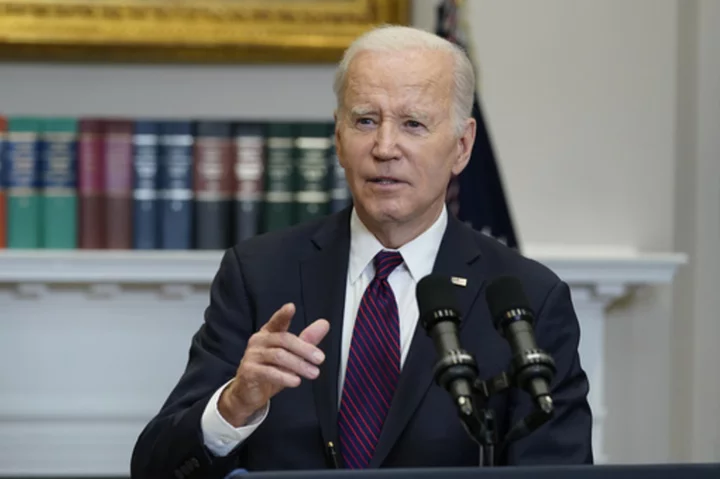WASHINGTON (AP) — President Joe Biden predicted Tuesday that the U.S.-Mexico border would be “chaotic for a while" when pandemic-related restrictions end, as 550 active-duty troops began arriving and migrants weighed whether or when to cross.
The restrictions have been in place since 2020, and allowed U.S. officials to quickly return migrants over the border. They are ending later this week and the U.S. is putting into place a set of new policies that will clamp down on illegal crossings while offering migrants a legal path to the United States if they apply online through a government app, have a sponsor and pass background checks.
Biden said his administration was working to make the change orderly. “But it remains to be seen," he told reporters. "It's going to be chaotic for a while.”
Biden and Mexican President Andrés Manuel López Obrador spoke for roughly an hour Tuesday to discuss the border. Mexico shares a 1,951-mile border with the United States, so the nation is key to the success of any plans by the United States to control immigration at the southern border.
Migrants are already arriving. Agents in the Border Patrol’s relatively quiet El Centro, California, sector stopped about 260 migrants a day over a four- or five-day period through Sunday, up from about 90 a day the previous week, said Gregory Bovino, the sector chief. On Monday, agents found migrants from 22 countries.
It’s unclear what’s driving the increase other than anticipation that pandemic restrictions are about to end, Bovino said.
“We see these surges whenever there’s a major event or a news story,” he said. “We don’t have a crystal ball, so I can’t say there’s going to be a massive surge on Friday.”
In the Mexican border city of Reynosa, across from McAllen, Texas, groups handed out fliers Tuesday that explained in English and Haitian Creole how to register for the CBP One app that the U.S. has been using to allow migrants to schedule an appointment to try to gain admittance to the U.S.
Standing in Reynosa’s central square Tuesday, Phanord Renel of Haiti said he would not risk deportation to cross. “We don’t want to go back there (Haiti) because the situation is very complicated there,” he said. “If we can’t cross, we have to put up with it here, maybe the government will do something for us, but cross illegally — no.”
U.S. and international law give migrants the right to seek asylum. However, the U.S. has used Title 42 of a public health law to expel migrants with no chance at asylum 2.8 million times since March 2020 on the grounds of preventing the spread of COVID-19.
The Biden administration has said it is ready to deal with whatever happens after Title 42's use ends, although it has also repeatedly criticized Congress for not making changes to the country's immigration system.
“We believe we have a robust process to deal with what is going to occur after Title 42 lifts. Again, we’re using the tools that are available to us because Congress refuses to do their job as it relates to the border," White House press secretary Karine Jean-Pierre said Tuesday.
The movement of troops is part of efforts to beef up security along the southern border, but they will mainly be used to help monitor and watch the border, or do data entry and support, and are “not there in any way to be interacting with migrants,” said Brig. Gen. Pat Ryder, Pentagon press secretary. The goal is to free up U.S. Customs and Border Protection personnel to do law enforcement activities.
At least some of the active-duty troops will be used near El Paso, Texas, he said, while adding that CBP will decide where forces will go. More than 900 additional soldiers, Marines and airmen will follow around the end of May.
Roughly 2,500 National Guard members are already spread across all sectors of the border, providing an array of support to CBP, including monitoring, detection and air transportation. Separately, Texas National Guard troops are also working along the border under state authority.
Even with the COVID-19 asylum restrictions still in place, the administration has seen record numbers of people crossing the border. The Biden administration's plan is meant to crack down on those who cross illegally and by creating new pathways meant to offer alternatives to a dangerous and often deadly journey.
Some migrants have been spurred by false information from smugglers or widespread rumors about what the changes will mean for their chances of being able to remain in the U.S.
“It’s a very complicated legal system and it’s becoming increasingly difficult to communicate the realities of our clients,” Daniel Berlin, of the International Rescue Committee, said. ”While we try to communicate the most accurate and up to date information that we have, smugglers and traffickers and other bad actors are communicating false information.”
Effects have also been felt far from the southern border. In Chicago, Mayor Lori Lightfoot issued an emergency declaration in response to a tenfold increase in the number of asylum-seekers arriving in the city in need of temporary shelter and other help.
Chicago officials have warned for several weeks that its shelters can't accommodate the larger number of migrants arriving daily since late April. Migrants have been sheltering inside city police stations or airports because city-run shelters are full.
___
Associated Press reporters Rebecca Santana, Elliot Spagat in Imperial, California, Mark Stevenson in Mexico City, Katie Foody in Chicago, Gerardo Carrillo in Reynosa, Mexico contributed to this report.









